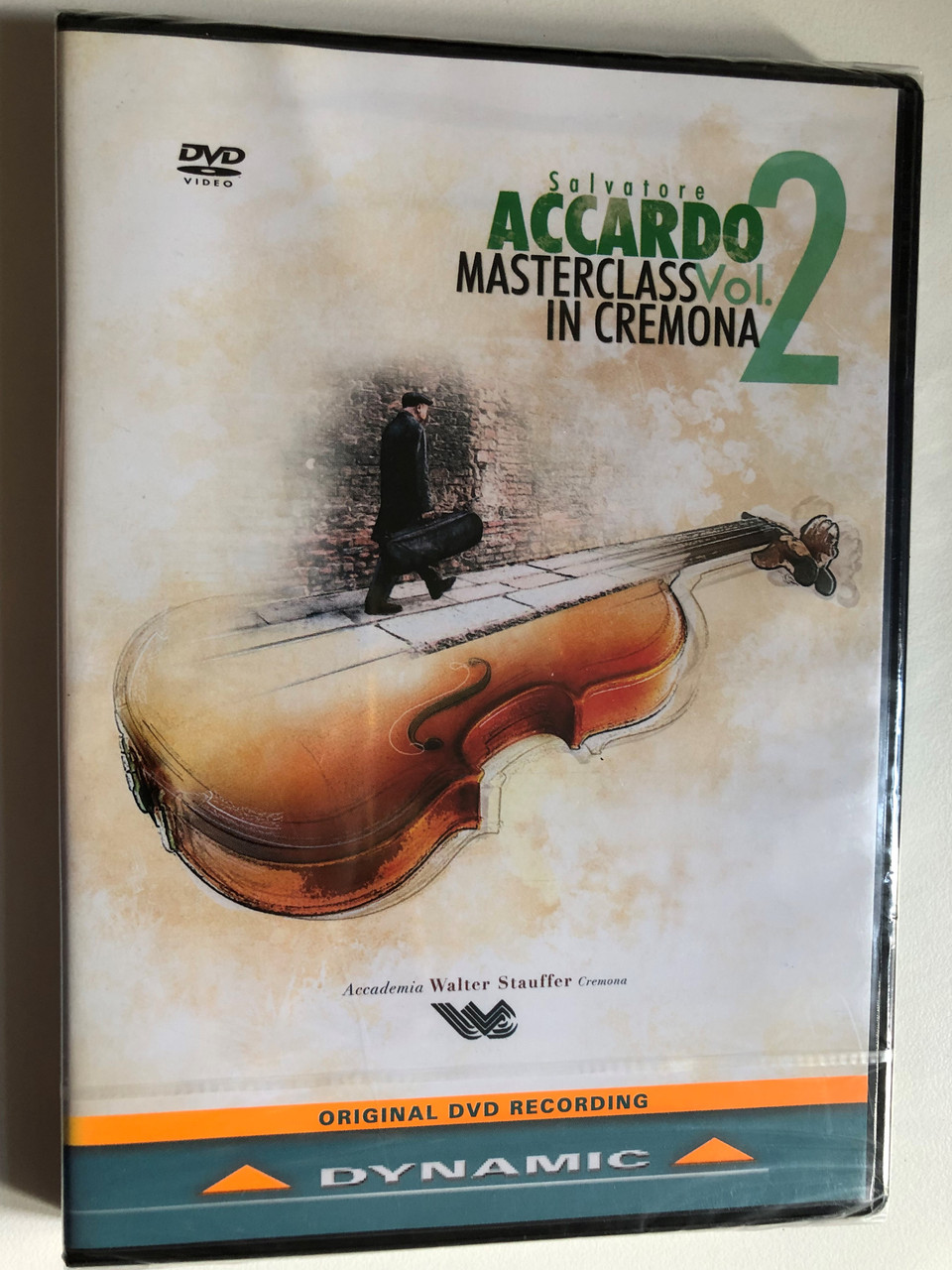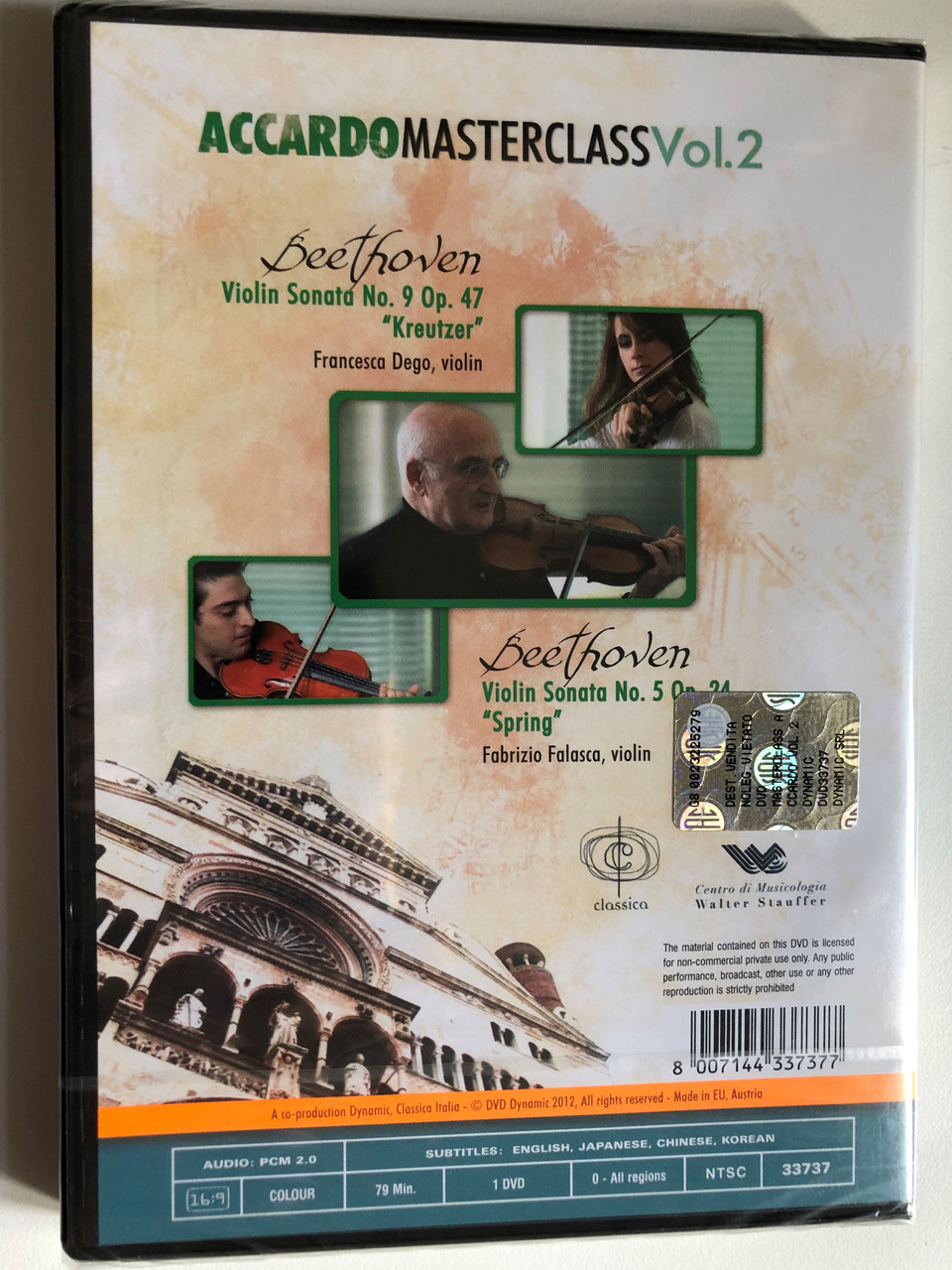Description
Salvatore Accardo - Masterclass in Cremona, Vol. 2 / Beethoven Violin Sonata No. 9 Op. 47 "Kreutzer" Francesca Dego, violin / Beethoven Violin Sonata No. 9 Op. 47 "Kreutzer" Francesca Dego, violin / DVD
Format: NTSC
Run time: 79 Minutes
UPC: 8007144337377
- Aspect Ratio : 1.78:1
- MPAA rating : Unrated (Not Rated)
- Product Dimensions : 7.75 x 5.75 x 0.5 inches; 3.2 Ounces
- Item model number : DYN-33737
- Media Format : Multiple Formats, Color, NTSC, Widescreen, Classical
- Release date : January 29, 2013
- Actors : Leonardi, Beethoven, Falasca, Bellocchio, Dego
- Subtitles: : English, Japanese, Chinese, Korean
- Studio : Dynamic
- Number of discs : 1
Dynamic is happy to feature a series of DVDs proposing the master classes held by Salvatore Accardo in Cremona (the world capital of Violin Making) at the famous Walter Stauffer Musicology Centre in 2011. These classes are dedicated to several of the most famous pieces of the violin repertoire (both chamber and virtuosic music).
Salvatore Accardo’s Masterclass series from Cremona continues with this, the second volume. His appearance at the summer course in the Walter Stauffer Academy usually heralds the appearance of other outstanding Italian string players, such as violist Bruno Giuranna, cellist Rocco Filippini and double bassist Franco Petracchi.
In this disc, which was filmed in April 2011, he coaches two talented young violinists in Beethoven sonatas. In the Spring sonata Fabrizio Falasca is accompanied by Maria Grazia Bellocchio whilst in the Kreutzer Francesca Dego is partnered with the youthful and lively pianist Francesca Leonardi.
It’s fascinating to observe the informal tutelage and the manner of Accardo’s acutely penetrating but genial instruction. And he has clearly worked with both before, given some of the comments, especially those made by Dego, which means that there is no radical reshaping of interpretation, rather focusing on matters of detail.
With Falasca he is keen to ensure that the young fiddler avoids rushing and keeps a steady but flexible rhythm (Anglophone speakers will clearly need the subtitles here). It’s droll to observeAccardo circle his student heavily finger-clicking the rhythm to keep his errant student from rushing his bars. He is also keen to ensure a full body of tone, adding; ‘When you do something, do it’, which will henceforth become my own mantra. Crescendi and dynamics are obviously subjects of interest, so too up or down bow. Focus in the slow movement is on crescendo formation but on avoidance of diminuendi. Legato is a primary concern, and ‘false’ accents are pounced on and with soothing wit, firmly dispatched from the young player’s musical lexicon. If you have ever seen footage of Heifetz’s tense, austere master-classes you will find Accardo almost his exact opposite.
Only the first two movements of the Spring are run through. In the case of the Kreutzer, the statuesque Francesca Dego plays all the way through the formidable first movement. I suspect Accardo has worked more closely with her and pianist Francesca Leonardi. ‘Plays well, doesn’t she?’ he says jokily to the listening Falasca (indeed she does). Tempo relationships are a point of concern, however, and so too her tendency to stop her sound. And with her, too, he feels it necessary to beat a rhythm for her, and remind her that one section is taken too slowly and that her adagio passage should be an andante. The gain in flexibility and fluidity of pulse is immediately apparent. He corrects both pianists too but always—always— with warmth and encouragement. This session is notably relaxed, collegiate and fun, but hardworking too. ‘Try it—not now, perhaps, but it will work musically’, Accardo adds, and this is perhaps the essence of his help: practical concentration on both nuts and bolts but also phrasal sweep and a proper concern for legato and shaping, and ensuring adherence to the full measure of the score.
Quietly inspiring, I greatly enjoyed the second volume. I look forward to hearing much more from the musiciansincluded in the classes.


























